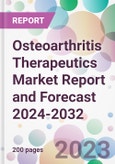The osteoarthritis therapeutics market size was valued at USD 9.1 billion in 2023, driven by the increasing geriatric population across the globe. The market size is anticipated to grow at a CAGR of 8.7% during the forecast period of 2024-2032 to achieve a value of USD 19.1 billion by 2032.
Osteoarthritis Therapeutics: Introduction
Osteoarthritis therapeutics refer to the various treatment options and approaches used to manage and alleviate the symptoms of osteoarthritis, a common degenerative joint disease characterized by the breakdown of cartilage in the joints. Osteoarthritis primarily affects the knees, hips, hands, and spine and can result in joint pain, stiffness, reduced mobility, and decreased quality of life. The choice of therapeutic interventions depends on the severity of the condition, the affected joints, and individual patient needs.Key Trends in the Osteoarthritis Therapeutics Market
Here are some key trends influencing the market:
- Biologics and Regenerative Therapies: The use of biologics, including platelet-rich plasma (PRP) and stem cell therapies, is a growing trend in osteoarthritis treatment. These therapies aim to promote tissue repair and regeneration.
- Precision Medicine: Advancements in genomics and biomarker research are leading to the development of personalized treatment plans based on the patient's genetic and molecular profile, optimizing therapeutic outcomes.
- Telemedicine and Remote Monitoring: Telehealth and remote monitoring solutions are increasingly used for patient consultations and follow-ups, making it more convenient for osteoarthritis patients to access care and track their progress.
- Patient Education and Engagement: The availability of online resources and educational materials empowers patients to take an active role in managing their osteoarthritis. Healthcare providers are focusing on patient education and engagement to improve adherence to treatment plans.
- Wearable Technology: Wearable devices, such as smart braces and activity trackers, are becoming valuable tools for monitoring joint health, tracking physical activity, and providing real-time feedback to patients.
- Nutraceuticals and Supplements: The use of dietary supplements and nutraceuticals, such as glucosamine, chondroitin, and turmeric, is a growing trend among osteoarthritis patients seeking alternative or complementary therapies.
Osteoarthritis Therapeutics Market Segmentations
Market Breakup by Type
- Hip Osteoarthritis
- Spinal Osteoarthritis
- Knee Osteoarthritis
- Hand Osteoarthritis
- Others
Market Breakup by Drug Class
- Nonsteroidal Anti-inflammatory Drugs (NSAIDs)
- Analgesics
- Corticosteroids
- Hyaluronic Acid Injections
- Disease-modifying Osteoarthritis Drugs
- Others
Market Breakup by Doses Form
- Tablets and Capsules
- Injections
- Creams and Gels
- Others
Market Breakup by Route of Administration
- Oral
- Parenteral
- Topical
Market Breakup by End User
- Hospitals
- Specialty Clinics
- Homecare Settings
- Others
Market Breakup by Distribution Channel
- Hospitals Pharmacy
- Retail Pharmacy
- Online Pharmacy
- Others
Market Breakup by Region -7MM
- United States
- EU-4 and the United Kingdom
- Japan
Osteoarthritis Therapeutics Market Overview
Here are some market drivers impacting the market:
- Aging Population: The global aging population is a significant driver of the osteoarthritis therapeutics market. As individuals age, the risk of developing osteoarthritis increases, leading to a higher demand for treatments to manage the condition.
- Rising Prevalence: Osteoarthritis is one of the most common musculoskeletal disorders globally, with a rising prevalence. This increase in the number of affected individuals drives the need for effective therapeutics.
- Advancements in Treatment: Ongoing research and development efforts have led to the discovery of new treatment modalities, including disease-modifying drugs and regenerative therapies, which offer potential benefits for osteoarthritis patients.
- Patient-Centered Care: The shift toward patient-centered care models emphasizes personalized treatment plans tailored to individual patient needs and preferences. This trend influences treatment choices and the development of patient-friendly therapeutics.
- Technological Innovations: Advancements in medical technology, such as minimally invasive surgical techniques and imaging modalities, enhance the diagnosis and treatment of osteoarthritis, driving the demand for therapeutics.
- Healthcare Infrastructure Development: Investments in healthcare infrastructure, especially in emerging markets, contribute to improved access to osteoarthritis diagnosis and treatment, thereby expanding the market.
Osteoarthritis Therapeutics Market: Competitor Landscape
The key features of the market report include patent analysis, grants analysis, clinical trials analysis, funding and investment analysis, partnerships, and collaborations analysis by the leading key players.The major companies in the market are as follows:
- Pfizer Inc.
- Abbvie Inc.
- Novartis AG
- Amgen Inc.
- Boehringer Ingelheim International GmbH.
- Samsung Bioepis
- Merck & Co Inc.
- Sun Pharmaceutical Industries Ltd.
- Teva Pharmaceuticals Industries Ltd.
- AstraZeneca PL
- Zimmer Biomet
- Stryker Corporation
Table of Contents
1 Preface
3 Osteoarthritis Overview
4 Patient Profile
5 Osteoarthritis Epidemiology Analysis-7MM
6 Osteoarthritis Therapeutics Market Overview
7 Osteoarthritis Therapeutics Market Landscape
8 Osteoarthritis Therapeutics Challenges and Unmet Needs
10 Osteoarthritis Therapeutics Market Dynamics
11 Osteoarthritis Therapeutics Market Segmentation
12 United States Osteoarthritis Therapeutics Market
13 EU-5 and the United Kingdom Osteoarthritis Therapeutics Market
14 Japan Osteoarthritis Therapeutics Market
15 Regulatory Framework
16 Patent Analysis
17 Grants Analysis
18 Clinical Trials Analysis
19 Funding and Investment Analysis
20 Partnership and Collaborations Analysis
21 Supplier Landscape
22 Osteoarthritis Therapeutics - Distribution Model (Additional Insight)
24 Company Competitiveness Analysis (Additional Insight)
25 Payment Methods (Additional Insight)
Companies Mentioned
- Pfizer Inc.
- Abbive Inc.
- Novartis AG
- Amgen Inc.
- Boehringer Ingelheim International GmbH.
- F. Hoffmann-La Roche Ltd. Merck & Co Inc.
- Teva Pharmaceutical Industries Ltd.
- Sun Pharmaceutical Industries Ltd.
- AstraZeneca PL
- Zimmer Biomet
- Stryker Corporation
Methodology

LOADING...








